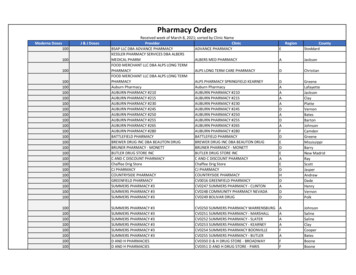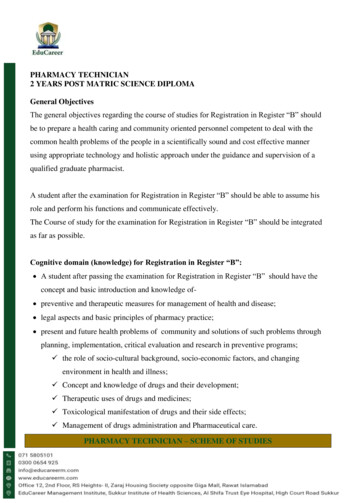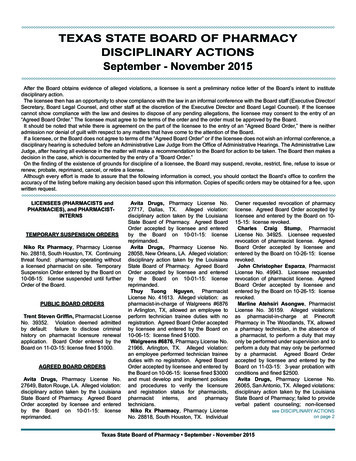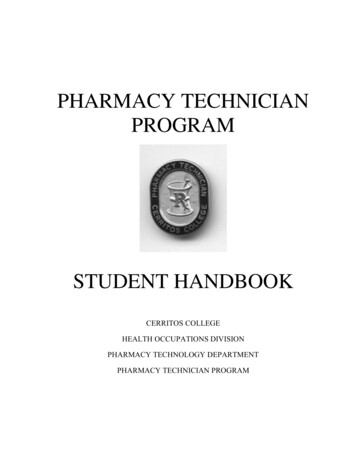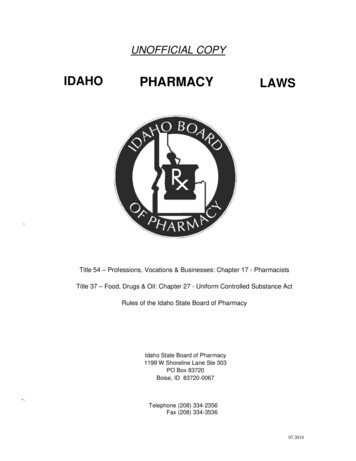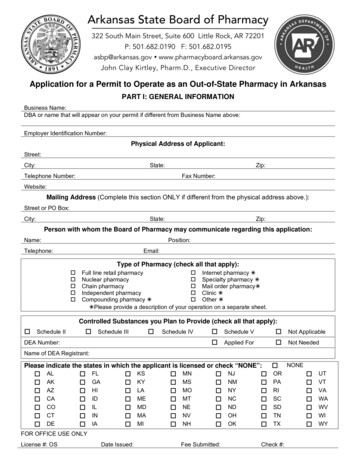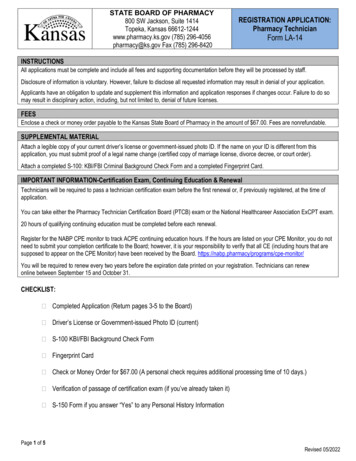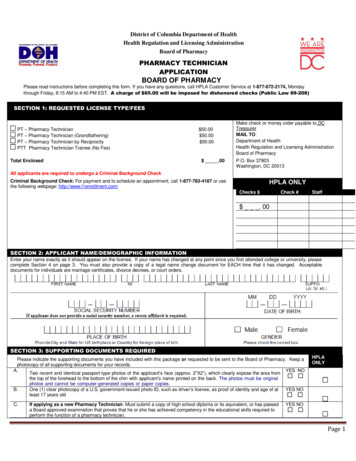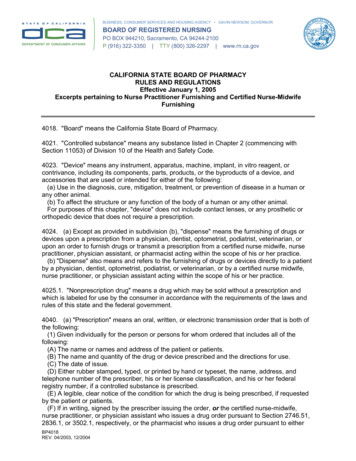
Transcription
BUSINESS, CONSUMER SERVICES AND HOUSING AGENCY GAVIN NEWSOM, GOVERNORBOARD OF REGISTERED NURSINGPO BOX 944210, Sacramento, CA 94244-2100P (916) 322-3350 TTY (800) 326-2297 www.rn.ca.govCALIFORNIA STATE BOARD OF PHARMACYRULES AND REGULATIONSEffective January 1, 2005Excerpts pertaining to Nurse Practitioner Furnishing and Certified Nurse-MidwifeFurnishing4018. "Board" means the California State Board of Pharmacy.4021. "Controlled substance" means any substance listed in Chapter 2 (commencing withSection 11053) of Division 10 of the Health and Safety Code.4023. "Device" means any instrument, apparatus, machine, implant, in vitro reagent, orcontrivance, including its components, parts, products, or the byproducts of a device, andaccessories that are used or intended for either of the following:(a) Use in the diagnosis, cure, mitigation, treatment, or prevention of disease in a human orany other animal.(b) To affect the structure or any function of the body of a human or any other animal.For purposes of this chapter, "device" does not include contact lenses, or any prosthetic ororthopedic device that does not require a prescription.4024. (a) Except as provided in subdivision (b), "dispense" means the furnishing of drugs ordevices upon a prescription from a physician, dentist, optometrist, podiatrist, veterinarian, orupon an order to furnish drugs or transmit a prescription from a certified nurse midwife, nursepractitioner, physician assistant, or pharmacist acting within the scope of his or her practice.(b) "Dispense" also means and refers to the furnishing of drugs or devices directly to a patientby a physician, dentist, optometrist, podiatrist, or veterinarian, or by a certified nurse midwife,nurse practitioner, or physician assistant acting within the scope of his or her practice.4025.1. "Nonprescription drug" means a drug which may be sold without a prescription andwhich is labeled for use by the consumer in accordance with the requirements of the laws andrules of this state and the federal government.4040. (a) "Prescription" means an oral, written, or electronic transmission order that is both ofthe following:(1) Given individually for the person or persons for whom ordered that includes all of thefollowing:(A) The name or names and address of the patient or patients.(B) The name and quantity of the drug or device prescribed and the directions for use.(C) The date of issue.(D) Either rubber stamped, typed, or printed by hand or typeset, the name, address, andtelephone number of the prescriber, his or her license classification, and his or her federalregistry number, if a controlled substance is prescribed.(E) A legible, clear notice of the condition for which the drug is being prescribed, if requestedby the patient or patients.(F) If in writing, signed by the prescriber issuing the order, or the certified nurse-midwife,nurse practitioner, or physician assistant who issues a drug order pursuant to Section 2746.51,2836.1, or 3502.1, respectively, or the pharmacist who issues a drug order pursuant to eitherBP4018REV. 04/2003, 12/2004
subparagraph (D) of paragraph (4) of, or clause (iv) of subparagraph (A) of paragraph (5) of,subdivision (a) of Section 4052.(2) Issued by a physician, dentist, optometrist, podiatrist, or veterinarian or, if a drug order isissued pursuant to Section2746.51, 2836.1, or 3502.1, by a certified nurse-midwife, nurse practitioner, or physicianassistant licensed in this state, or pursuant to either subparagraph (D) of paragraph (4) of, orclause (iv) of subparagraph (A) of paragraph (5) of, subdivision (a) of Section 4052 by apharmacist licensed in this state.(b) Notwithstanding subdivision (a), a written order of the prescriber for a dangerous drug,except for any Schedule II controlled substance, that contains at least the name and signatureof the prescriber, the name and address of the patient in a manner consistent with paragraph (3)of subdivision (b) of Section 11164 of the Health and Safety Code, the name and quantity of thedrug prescribed, directions for use, and the date of issue may be treated as a prescription by thedispensing pharmacist as long as any additional information required by subdivision (a) isreadily retrievable in the pharmacy. In the event of a conflict between this subdivision andSection 11164 of the Health and Safety Code, Section 11164 of the Health and Safety Codeshall prevail.(c) "Electronic transmission prescription" includes both image and data prescriptions."Electronic image transmission prescription" means any prescription order for which a facsimileof the order is received by a pharmacy from a licensed prescriber. "Electronic data transmissionprescription" means any prescription order, other than an electronic image transmissionprescription, that is electronically transmitted from a licensed prescriber to a pharmacy.(d) The use of commonly used abbreviations shall not invalidate an otherwise validprescription.(e) Nothing in the amendments made to this section (formerly Section 4036) at the 1969Regular Session of the Legislature shall be construed as expanding or limiting the right that achiropractor, while acting within the scope of his or her license, may have to prescribe a device.4050. (a) In recognition of and consistent with the decisions of the appellate courts of this state,the Legislature hereby declares the practice of pharmacy to be a profession.(b) Pharmacy practice is a dynamic patient-oriented health service that applies a scientificbody of knowledge to improve and promote patient health by means of appropriate drug use,drug-related therapy, and communication for clinical and consultative purposes.4051. (a) Except as otherwise provided in this chapter, it is unlawful for any person tomanufacture, compound, furnish, sell, or dispense any dangerous drug or dangerous device, orto dispense or compound any prescription pursuant to Section 4040 of a prescriber unless he orshe is a pharmacist under this chapter.(b) Notwithstanding any other law, a pharmacist may authorize the initiation of a prescription,pursuant to Section 4052, and otherwise provide clinical advice or information or patientconsultation if all of the following conditions are met:(1) The clinical advice or information or patient consultation is provided to a health careprofessional or to a patient.(2) The pharmacist has access to prescription, patient profile, or other relevant medicalinformation for purposes of patient and clinical consultation and advice.(3) Access to the information described in paragraph (2) is secure from unauthorized accessand use.4052. (a) Notwithstanding any other provision of law, a pharmacist may:(1) Furnish a reasonable quantity of compounded medication to a prescriber for office use bythe prescriber.(2) Transmit a valid prescription to another pharmacist.(3) Administer, orally or topically, drugs and biologicals pursuant to a prescriber's order.(4) Perform the following procedures or functions in a licensed health care facility inaccordance with policies, procedures, or protocols developed by health professionals, includingBP4018REV. 04/2003, 12/20042
physicians, pharmacists, and registered nurses, with the concurrence of the facilityadministrator:(A) Ordering or performing routine drug therapy-related patient assessment proceduresincluding temperature, pulse, and respiration.(B) Ordering drug therapy-related laboratory tests.(C) Administering drugs and biologicals by injection pursuant to a prescriber's order (theadministration of immunizations under the supervision of a prescriber may also be performedoutside of a licensed health care facility).(D) Initiating or adjusting the drug regimen of a patient pursuant to an order or authorizationmade by the patient's prescriber and in accordance with the policies, procedures, or protocols ofthe licensed health care facility.(5) (A) Perform the following procedures or functions as part of the care provided by a healthcare facility, a licensed home health agency, a licensed clinic in which there is a physicianoversight, a provider who contracts with a licensed health care service plan with regard to thecare or services provided to the enrollees of that health care service plan, or a physician, inaccordance, as applicable, with policies, procedures, or protocols of that facility, the homehealth agency, the licensed clinic, the health care service plan, or that physician, in accordancewith subparagraph (C):(i) Ordering or performing routine drug therapy-related patient assessment proceduresincluding temperature, pulse, and respiration.(ii) Ordering drug therapy-related laboratory tests.(iii) Administering drugs and biologicals by injection pursuant to a prescriber's order (theadministration of immunizations under the supervision of a prescriber may also be performedoutside of a licensed health care facility).(iv) Initiating or adjusting the drug regimen of a patient pursuant to a specific written order orauthorization made by the individual patient's treating prescriber, and in accordance with thepolicies, procedures, or protocols of the health care facility, home health agency, licensed clinic,health care service plan, or physician. Adjusting the drug regimen does not include substitutingor selecting a different drug, except as authorized by the protocol. The pharmacist shall providewritten notification to the patient's treating prescriber, or enter the appropriate information in anelectronic patient record system shared by the prescriber, of any drug regimen initiated pursuantto this clause within 24 hours.(B) A patient's treating prescriber may prohibit, by written instruction, any adjustment orchange in the patient's drug regimen by the pharmacist.(C) The policies, procedures, or protocols referred to in this paragraph shall be developed byhealth care professionals, including physicians, pharmacists, and registered nurses, and, at aminimum, meet all of the following requirements:(i) Require that the pharmacist function as part of a multidisciplinary group that includesphysicians and direct care registered nurses. The multidisciplinary group shall determine theappropriate participation of the pharmacist and the direct care registered nurse.(ii) Require that the medical records of the patient be available to both the patient's treatingprescriber and the pharmacist.(iii) Require that the procedures to be performed by the pharmacist relate to a condition forwhich the patient has first been seen by a physician.(iv) Except for procedures or functions provided by a health care facility, a licensed clinic inwhich there is physician oversight, or a provider who contracts with a licensed health care planwith regard to the care or services provided to the enrollees of that health care service plan,require the procedures to be performed in accordance with a written, patient-specific protocolapproved by the treating or supervising physician. Any change, adjustment, or modification ofan approved preexisting treatment or drug therapy shall be provided in writing to the treating orsupervising physician within 24 hours.(6) Manufacture, measure, fit to the patient, or sell and repair dangerous devices or furnishinstructions to the patient or the patient's representative concerning the use of those devices.(7) Provide consultation to patients and professional information, including clinical orpharmacological information, advice, or consultation to other health care professionals.BP4018REV. 04/2003, 12/20043
(8) (A) Furnish emergency contraception drug therapy in accordance with either of thefollowing:(i) Standardized procedures or protocols developed by the pharmacist and an authorizedprescriber who is acting within his or her scope of practice.(ii) Standardized procedures or protocols developed and approved by both the board and theMedical Board of California in consultation with the American College of Obstetricians andGynecologists, the California Pharmacist Association, and other appropriate entities. Both theboard and the Medical Board of California shall have authority to ensure compliance with thisclause, and both boards are specifically charged with the enforcement of this provision withrespect to their respective licensees. Nothing in this clause shall be construed to expand theauthority of a pharmacist to prescribe any prescription medication.(B) Prior to performing a procedure authorized under this paragraph, a pharmacist shallcomplete a training program on emergency contraception that consists of at least one hour ofapproved continuing education on emergency contraception drug therapy.(C) A pharmacist, pharmacist's employer, or pharmacist's agent may not directly charge apatient separate consultation fee for emergency contraception drug therapy services initiatedpursuant to this paragraph, but may charge an administrative fee not to exceed ten dollars ( 10)above the retail cost of the drug. Upon an oral, telephonic, electronic, or written request from apatient or customer, a pharmacist or pharmacist's employee shall disclose the total retail pricethat a consumer would pay for emergency contraception drug therapy. As used in thissubparagraph, total retail price includes providing the consumer with specific informationregarding the price of the emergency contraception drugs and the price of the administrative feecharged. This limitation is not intended to interfere with other contractually agreed-upon termsbetween a pharmacist, a pharmacist's employer, or a pharmacist's agent, and a health careservice plan or insurer. Patients who are insured or covered and receive a pharmacy benefitthat covers the cost of emergency contraception shall not be required to pay an administrativefee. These patients shall be required to pay copayments pursuant to the terms and conditionsof their coverage. The provisions of this subparagraph shall cease to be operative for dedicatedemergency contraception drugs when these drugs are reclassified as over-the-counter productsby the federal Food and Drug Administration.(D) A pharmacist may not require a patient to provide individually identifiable medicalinformation that is not specified in Section 1707.1 of Title 16 of the California Code ofRegulations before initiating emergency contraception drug therapy pursuant to this paragraph.(b) (1) Prior to performing any procedure authorized by paragraph (4) of subdivision (a), apharmacist shall have received appropriate training as prescribed in the policies and proceduresof the licensed health care facility.(2) Prior to performing any procedure authorized by paragraph (5) of subdivision (a), apharmacist shall have either (A) successfully completed clinical residency training or (B)demonstrated clinical experience in direct patient care delivery.(3) For each emergency contraception drug therapy initiated pursuant to paragraph (8) ofsubdivision (a), the pharmacist shall provide the recipient of the emergency contraception drugswith a standardized factsheet that includes, but is not limited to, the indications for use of thedrug, the appropriate method for using the drug, the need for medical followup, and otherappropriate information. The board shall develop this form in consultation with the StateDepartment of Health Services, the American College of Obstetricians and Gynecologists, theCalifornia Pharmacists Association, and other health care organizations. The provisions of thissection do not preclude the use of existing publications developed by nationally recognizedmedical organizations.(c) A pharmacist who is authorized to issue an order to initiate or adjust a controlledsubstance therapy pursuant to this section shall personally register with the federal DrugEnforcement Administration.(d) Nothing in this section shall affect the requirements of existing law relating to maintainingthe confidentiality of medical records.(e) Nothing in this section shall affect the requirements of existing law relating to the licensingof a health care facility.BP4018REV. 04/2003, 12/20044
4052.1. Notwithstanding Section 2038 or any other provision of law, a pharmacist may performskin puncture in the course of performing routine patient assessment procedures or in thecourse of performing any procedure authorized under Section 1206.5. For purposes of thissection, "routine patient assessment procedures" means: (a) procedures that a patient could,with or without a prescription, perform for himself or herself, or (b) clinical laboratory tests thatare classified as waived pursuant to the federal Clinical Laboratory Improvement Amendmentsof 1988 (42 U.S.C. Sec. 263a) and the regulations adopted thereunder by the federal HealthCare Financing Administration, as authorized by paragraph (11) of subdivision (a) of Section1206.5. A pharmacist performing these functions shall report the results obtained from a test tothe patient and any physician designated by the patient. Any pharmacist who performs theservice authorized by this section shall not be in violation of Section 2052.4052.7. (a) A pharmacy may, at a patient's request, repackage a drug previously dispensed tothe patient or to the patient's agent pursuant to a prescription.(b) Any pharmacy providing repackaging services shall have in place policies and proceduresfor repackaging these drugs and shall label the repackaged prescription container with thefollowing:(1) All the information required by Section 4076.(2) The name and address of the pharmacy repackaging the drug and the name and addressof the pharmacy that initially dispensed the drug to the patient.(c) The repackaging pharmacy and the pharmacy that initially dispensed the drug shall only beliable for its own actions in providing the drug to the patient or the patient's agent.4060. No person shall possess any controlled substance, except that furnished to a personupon the prescription of a physician, dentist, podiatrist, optometrist, or veterinarian, or furnishedpursuant to a drug order issued by a certified nurse-midwife pursuant to Section 2746.51, anurse practitioner pursuant to Section 2836.1, a physician assistant pursuant to Section 3502.1,or a pharmacist pursuant to either subparagraph (D) of paragraph (4) of, or clause (iv) ofsubparagraph (A) of paragraph (5) of, subdivision (a) of Section 4052. This section shall notapply to the possession of any controlled substance by a manufacturer, wholesaler, pharmacy,pharmacist, physician, podiatrist, dentist, optometrist, veterinarian, certified nurse-midwife,nurse practitioner, or physician assistant, when in stock in containers correctly labeled with thename and address of the supplier or producer.Nothing in this section authorizes a certified nurse-midwife, a nurse practitioner, or a physicianassistant to order his or her own stock of dangerous drugs and devices.4070. (a) Except as provided in Section 4019 and subdivision (b), an oral or an electronic datatransmission prescription as defined in subdivision (c) of Section 4040 shall as soon aspracticable be reduced to writing by the pharmacist and shall be filled by, or under the directionof, the pharmacist. The pharmacist need not reduce to writing the address, telephone number,license classification, federal registry number of the prescriber or the address of the patient orpatients if the information is readily retrievable in the pharmacy.(b) A pharmacy receiving an electronic transmission prescription shall not be required toreduce that prescription to writing or to hard copy form if, for three years from the last date offurnishing pursuant to that prescription or order, the pharmacy is able, upon request by theboard, to immediately produce a hard copy report that includes for each date of dispensing of adangerous drug or dangerous device pursuant to that prescription or order: (1) all of theinformation described in subparagraphs (A) to (E), inclusive, of paragraph (1) of subdivision (a)of Section 4040, and (2) the name or identifier of the pharmacist who dispensed the dangerousdrug or dangerous device. This subdivision shall not apply to prescriptions for controlledsubstances classified in Schedule II, III, IV, or V, except as permitted pursuant to Section11164.5 of the Health and Safety Code.(c) If only recorded and stored electronically, on magnetic media, or in any other computerizedform, the pharmacy's computer system shall not permit the received information or theBP4018REV. 04/2003, 12/20045
dangerous drug or dangerous device dispensing information required by this section to bechanged, obliterated, destroyed, or disposed of, for the record maintenance period required bylaw once the information has been received by the pharmacy and once the dangerous drug ordangerous device has been dispensed. Once a dangerous drug or dangerous device has beendispensed, if the previously created record is determined to be incorrect, a correcting additionmay be made only by or with the approval of a pharmacist. After a pharmacist enters thechange or enters his or her approval of the change into the computer, the resulting record shallinclude the correcting addition and the date it was made to the record, the identity of the personor pharmacist making the correction, and the identity of the pharmacist approving the correction.(d) Nothing in this section shall impair the requirement to have an electronically transmittedprescription transmitted only to the pharmacy of the patient's choice or to have a writtenprescription. This requirement shall not apply to orders for medications to be administered in anacute care hospital.4072. (a) Notwithstanding any other provision of law, a pharmacist, registered nurse, licensedvocational nurse, licensed psychiatric technician, or other healing arts licentiate, if so authorizedby administrative regulation, who is employed by or serves as a consultant for a licensed skillednursing, intermediate care, or other health care facility, may orally or electronically transmit tothe furnisher a prescription lawfully ordered by a person authorized to prescribe drugs ordevices pursuant to Sections 4040 and 4070. The furnisher shall take appropriate steps todetermine that the person who transmits the prescription is authorized to do so and shall recordthe name of the person who transmits the order. This section shall not apply to orders forSchedule II controlled substances.(b) In enacting this section, the Legislature recognizes and affirms the role of the Departmentof Health Services in regulating drug order processing requirements for licensed health carefacilities as set forth in Title 22 of the California Code of Regulations as they may be amendedfrom time to time.4075. No prescription for a controlled substance transmitted by means of an oral orelectronically transmitted order shall be furnished to any person unknown and unable toproperly establish his or her identity. The board may by regulation establish procedures toprevent unauthorized persons from receiving prescription drugs furnished to a patient or arepresentative of the patient.4076. (a) A pharmacist shall not dispense any prescription except in a container that meets therequirements of state and federal law and is correctly labeled with all of the following:(1) Except where the prescriber or the certified nurse-midwife who functions pursuant to astandardized procedure or protocol described in Section 2746.51, the nurse practitioner whofunctions pursuant to a standardized procedure described in Section 2836.1, or protocol, thephysician assistant who functions pursuant to Section 3502.1, or the pharmacist who functionspursuant to a policy, procedure, or protocol pursuant to either subparagraph (D) of paragraph(4) of, or clause (iv) of subparagraph (A) of paragraph (5) of, subdivision (a) of Section 4052orders otherwise, either the manufacturer's trade name of the drug or the generic name and thename of the manufacturer. Commonly used abbreviations may be used. Preparationscontaining two or more active ingredients may be identified by the manufacturer's trade name orthe commonly used name or the principal active ingredients.(2) The directions for the use of the drug.(3) The name of the patient or patients.(4) The name of the prescriber or, if applicable, the name of the certified nurse-midwife whofunctions pursuant to a standardized procedure or protocol described in Section 2746.51, thenurse practitioner who functions pursuant to a standardized procedure described in Section2836.1, or protocol, the physician assistant who functions pursuant to Section 3502.1, or thepharmacist who functions pursuant to a policy, procedure, or protocol pursuant to eithersubparagraph (D) of paragraph (4) of, or clause (iv) of subparagraph (A) of paragraph (5) of,subdivision (a) of Section4052.BP4018REV. 04/2003, 12/20046
(5) The date of issue.(6) The name and address of the pharmacy, and prescription number or other means ofidentifying the prescription.(7) The strength of the drug or drugs dispensed.(8) The quantity of the drug or drugs dispensed.(9) The expiration date of the effectiveness of the drug dispensed.(10) The condition for which the drug was prescribed if requested by the patient and thecondition is indicated on the prescription.(11) (A) Commencing January 1, 2006, the physical description of the dispensed medication,including its color, shape, and any identification code that appears on the tablets or capsules,except as follows:(i) Prescriptions dispensed by a veterinarian.(ii) An exemption from the requirements of this paragraph shall be granted to a new drug forthe first 120 days that the drug is on the market and for the 90 days during which the nationalreference file has no description on file.(iii) Dispensed medications for which no physical description exists in any commerciallyavailable database.(B) This paragraph applies to outpatient pharmacies only.(C) The information required by this paragraph may be printed on an auxiliary label that isaffixed to the prescription container.(D) This paragraph shall not become operative if the board, prior to January 1, 2006, adoptsregulations that mandate the same labeling requirements set forth in this paragraph.(b) If a pharmacist dispenses a prescribed drug by means of a unit dose medication system,as defined by administrative regulation, for a patient in a skilled nursing, intermediate care, orother health care facility, the requirements of this section will be satisfied if the unit dosemedication system contains the aforementioned information or the information is otherwisereadily available at the time of drug administration.(c) If a pharmacist dispenses a dangerous drug or device in a facility licensed pursuant toSection 1250 of the Health and Safety Code, it is not necessary to include on individual unitdose containers for a specific patient, the name of the certified nurse-midwife who functionspursuant to a standardized procedure or protocol described in Section 2746.51, the nursepractitioner who functions pursuant to a standardized procedure described in Section 2836.1, orprotocol, the physician assistant who functions pursuant to Section 3502.1, or the pharmacistwho functions pursuant to a policy, procedure, or protocol pursuant to either subparagraph (D)of paragraph (4) of, or clause (iv) of subparagraph (A) of paragraph (5) of, subdivision (a) ofSection 4052.(d) If a pharmacist dispenses a prescription drug for use in a facility licensed pursuant toSection 1250 of the Health and Safety Code, it is not necessary to include the informationrequired in paragraph (11) of subdivision (a) when the prescription drug is administered to apatient by a person licensed under the Medical Practice Act (Chapter 5 (commencing withSection 2000)), the Nursing Practice Act (Chapter 6 (commencing with Section 2700)), or theVocational Nursing Practice Act (Chapter 6.5 (commencing with Section 2840)), who is actingwithin his or her scope of practice.4077. (a) Except as provided in subdivisions (b) and (c), no person shall dispense anydangerous drug upon prescription except in a container correctly labeled with the informationrequired by Section 4076.(b) Physicians, dentists, podiatrists, and veterinarians may personally furnish any dangerousdrug prescribed by them to the patient for whom prescribed, provided that the drug is properlylabeled to show all information required in Section 4076 except the prescription number.(c) Devices that bear the legend "Caution: federal law restricts this device to sale by or on theorder of a ," or words of similar meaning, are exempt from the requirements of Section4076, and Section 111480 of the Health and Safety Code, when provided to patients in skillednursing facilities or intermediate care facilities licensed pursuant to Chapter 2 (commencing withSection 1250) of Division 2 of the Health and Safety Code.BP4018REV. 04/2003, 12/20047
(d) The following notification shall be affixed to all quantities of dimethyl sulfoxide (DMSO)prescribed by a physician, or dispensed by a pharmacy pursuant to the order of a physician inCalifornia: "Warning: DMSO may be hazardous to your health. Follow the directions of thephysician who prescribed the DMSO for you."(e) The label of any retail package of DMSO shall include appropriate precautionary measuresfor proper handling and first aid treatment and a warning statement to keep the product out ofreach of children.4170. (a) No prescriber shall dispense drugs or dangerous devices to patients in his or heroffice or place of practice unless all of the following conditions are met:(1) The dangerous drugs or dangerous devices are dispensed to the prescriber's own patient,and the drugs or dangerous devices are not furnished by a nurse or physician attendant.(2) The dangerous drugs or dangerous devices are necessary in the treatment of the conditionfor which the prescriber is attending the patient.(3) The prescriber does not keep a pharmacy, open shop, or drugst
CALIFORNIA STATE BOARD OF PHARMACY . RULES AND REGULATIONS Effective January 1, 2005 Excerpts pertaining to Nurse Practitioner Furnishing and Certified NurseMidwife - Furnishing 4018. "Board" means the California State Board of Pharmacy. 4021. "Controlled substance" means any substance listed in Chapter 2 (commencing with
